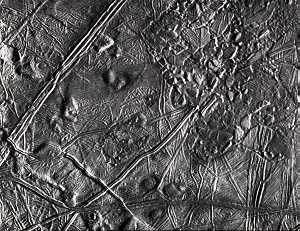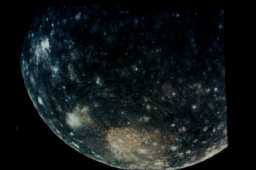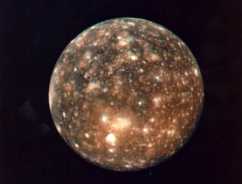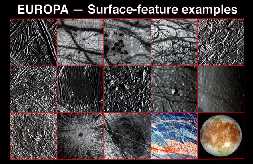This collage shows images obtained of Europa during the Galileo mission, including many interesting surface features of this moon.
Click on image for full size
NASA
Surface of Europa
The picture to the left shows examples of the many amazing different surface features of Europa.
Many exciting discoveries were made about Europa during the
Galileo mission. The surface of Europa is unusual, even for an icy moon. It appears that the surface has been newly re-surfaced, rather than being ancient. Instead of craters, there appear to be unusual cracks extending for many kilometers over the entire surface. Startling new closeup images from the Galileo spacecraft reveal a surface that suggests the presence of a
submerged ocean.
Besides evidence for an ocean, the surface of Europa also presents evidence for a form of volcanism found on Earth as well as on icy moons called
cryo-volcanism. This kind of geology includes faulting and crustal deformation common to environments where volcanism is found. The surface also shows evidence of
new molecules that form because of
radiation in the environment!
All this evidence for geologic activity points to the presence of active heating in the interior of Europa.
You might also be interested in:

The Galileo spacecraft was launched on October 19, 1989. Galileo had two parts: an orbiter and a descent probe that parachuted into Jupiter's atmosphere. Galileo's primary mission was to explore the Jovian
...more
The surface of Europa shows many signs of that there may be an ocean under the surface: * flooded terrain * 'freckles' * rafting * 'mushy' craters, and * spreading centers. Taken together, these pieces
...more
Europa was first discovered by Galileo Galilei in 1610, making it one of the Galilean Satellites. Europa is Jupiter's 4th largest moon, 670,900 km from Jupiter. With a diameter that is about half the distance
...more
The surface of Ganymede is halfway between that of Callisto and that of Europa. Portions of the crust are of ancient age, while other portions are relatively new. The little white dots shown in this image
...more
It is unlikely that the icy moons have an atmosphere. The reason they have no atmosphere is because they do not have enough gravity. Gravity depends upon the amount of substance (mass) contained in a body.
...more
Amalthea was discovered by E Barnard in 1872. Of the 17 moons it is the 3rd closest to Jupiter, with a standoff distance of 181,300 km. Amalthea is about the size of a county or small state, and is just
...more
Callisto was first discovered by Galileo in 1610, making it one of the Galilean Satellites. Of the 60 moons it is the 8th closest to Jupiter, with a standoff distance of 1,070,000 km. It is the 2nd largest
...more















